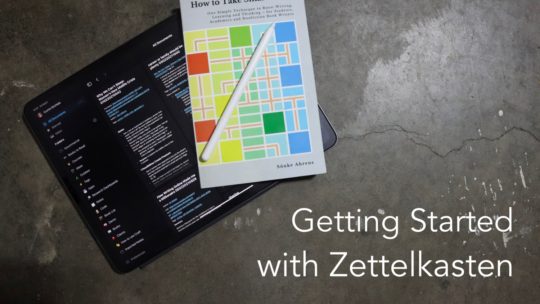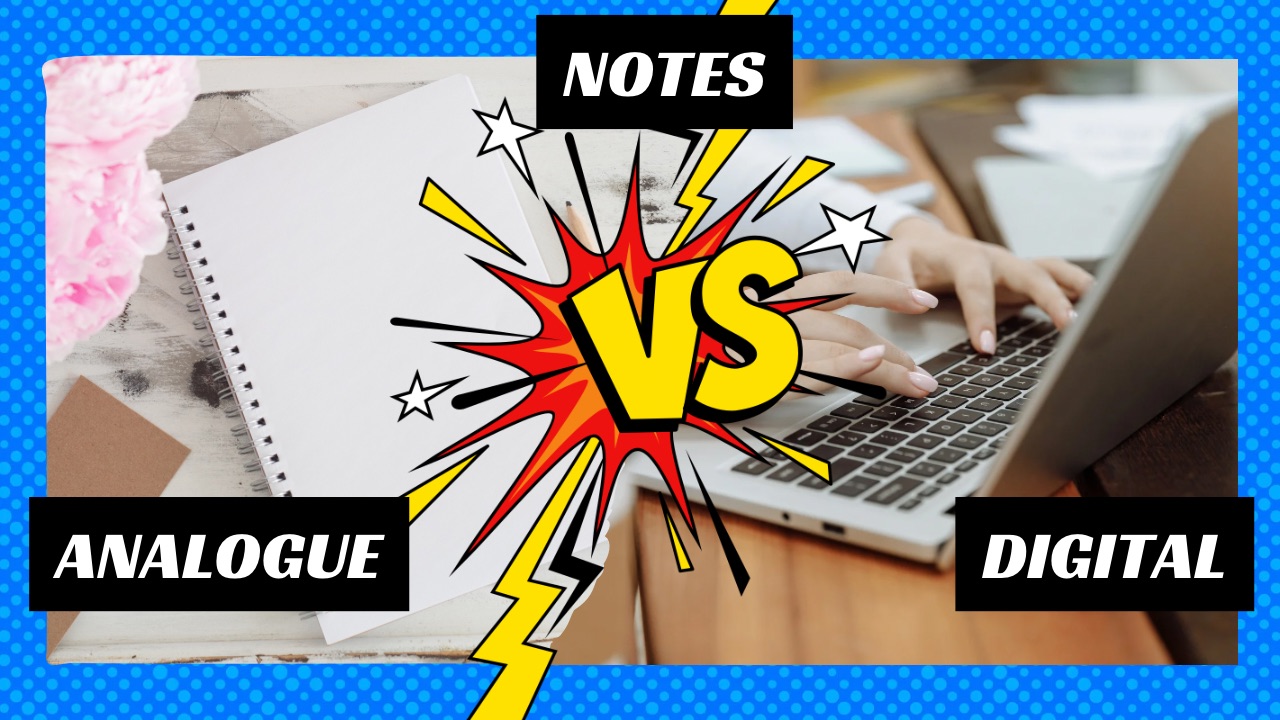The question of what type of note-taking software you should use has been hotly debated. There are proponents of every piece of software out there. But maybe you should take one step back from which piece of software you should use to ask yourself if you should be using software at all?
Maybe a pen and some type of paper is a better option than any piece of software out there.
Today we’re going to take a look at some of the pros and cons for physical vs digital note-taking systems.
Physical Note Systems Are the Best
One of the first points in favour of a physical note system is that you’re less prone to distraction when you’re using a physical note. With any computer, you can easily leave many different applications open in the background and then quickly change to these background distraction blackholes instead of looking at the notes/research on hand.
One study of students using laptops in the classroom found that the average student was generating more than 65 new active windows per lecture with 62% of those windows being classified as distracting windows1. Students surfed the web, shopped, and looked at messaging apps more than 50% of the time they were in class. This leads to less attention on the lecture which means it takes longer to learn the material in a meaningful way.
Tactility also matters in your note-taking. Oppenheimer and Mueller published a study in 2014 showing that students taking notes via laptop tend to write out the lecture points verbatim whereas those taking notes by hand summarized the points in their own words2. Writing down the lecture points verbatim means students spent less time thinking about what they were learning thus retaining less information about the lecture.
Anecdotally, I notice that when I read a physical book I can “remember” where something is in a book to a certain extent. When I go looking for a passage to reference I can usually find it within a few minutes of flipping through the book as I home in on the proper section. This never happens in a digital book as it’s far too hard to flip through the pages to start to find the right place to get find the idea I’m thinking of.

Getting Started with Zettelkasten
If you’ve been wondering about what Zettelkasten is and how to start organizing your notes with this excellent system then this course is for you. I’ll walk you through how I use this system to develop my reading research for posts like this one here. You can also become a member to get all my courses.
$99 USD (30-day guarantee)
One big detriment to physical note systems is that one note can only go in one spot. The physical note forums I check every week for PKM Weekly are full of questions about where a note should go. People agonize over this because there isn’t any type of tagging system that can let a note go in one spot, but then show up in multiple other spots and searches.
Another detriment to analogue systems is that there are no extra tools available to help surface connections in your notes you may have missed. Digital systems have plugins that can show you where connections exist that you may have missed. You could even run your own notes through any of the Large Language Models available currently to find relationships that don’t currently exist. Physical notes would have to be digitized first, thus losing some of their allure.
Finally, far too many people spend epic amounts of time making their physical notes “pretty”. This is most obvious when you look at the Bullet Journal community where 99% of the content is about the art pieces created from notebooks. While I love art, I can’t help but think that most of the work is put into making a notebook pretty and having a functional set of notes is only an afterthought.
Digital Note Systems are the Best
One of the biggest areas of benefit with a digital note system is that you have so many organizational tools at your fingertips. You can use tags, folders, search, tagnotes, and backlinks to help make connections between the notes you’re creating. These can operate seamlessly together in the note-taking app you use to enhance your productivity in research.
Backing up your digital notes is also an easy process. I have my digital notes on a laptop, iPad and desktop computer. I’ve also set up a sync to keep an archive of my notes on my home server that gets updated every day and another backup job which copies my notes into an online folder that’s synced with the internet. To lose my notes I’d have to lose 3 computers, 1 home server, Obsidian sync would have to die, and iCloud and all its redundant backups would have to die.
I figure if all of those data centers go down whatever happened was big enough that I’ll just be happy to have my family around me and my notes will be an afterthought.
With a digital tool, I’m never stuck without a method to add a note directly to my system. I can always pull my phone out to jot something down, or record a book title, or even save a web article to read later. With a physical system, I need to add a notebook/pen/notecard to my pockets so I have a way to take a note. Then I need to transfer it into the physical system when I’m back where I can access it.
A drawback to a digital system is the myriad of choices you have in how to organize your notes. Do you add a tag, or use tagnotes, or use folders. What should your folders be called, what are aliases? So many people agonize over their specific setup and often feel like there is some other better system out there for them to use.
With tools that have a solid plugin ecosystem, like Obsidian, you can always spend time shuffling through the plugins available to tweak your workflow. This feels like good work on your note system but is often simply a distraction technique. If you’re not taking notes, connecting notes, or producing something with your notes, then you’re not being productive with your notes.
The lack of friction in capture with digital tools has a dark side, it’s easy to collect a bunch of crap that does you no good. Saving 5 articles a day, that you never read, isn’t productive. This collection of resources is one of the easiest traps to fall into. Like I just said, if you’re not taking notes, connecting notes, or producing something with your notes then you’re not being productive.
Finally, digital systems are on digital devices. Digital devices contain so many distractions that can pull you away from doing good thinking. It’s easy to open up social media, or check your RSS feeds, or see if something cool is on sale at your favourite online shopping place. Each time you do one of these distracting things you’re increasing the cognitive residue. When you finally switch back to your note system you’ve got a bunch of other things sitting around in your brain that make it harder to have good thoughts. It takes a lot of discipline to stay away from these distractions.
What Should You Choose?
Ultimately, a good note system is better than any tool. It’s easy to read an article like this and decide your analogue/digital system is bad and you’re going to switch. You can’t always blame your tools though, most often the problem is you. Analogue or Digital can be an excellent system for your notes if you are disciplined enough to work inside the constraints of that system.
I use a hybrid system. When I’m reading books, they’re almost always physical. I use a notebook to take notes as I read. I later transfer those notes into Obsidian and make connections with other notes/books I have in Obsidian.
I like being able to sit on my deck in the summer with just a notebook and a book and no other distractions. At worst, I stop reading for a minute and look around my backyard or take a nap.
When I’m reading research papers, I like to use my iPad. The limited multi-tasking system available means I’m more likely to stay focused on my reading instead of looking at stuff that shouldn’t be my focus.
It’s also important to remember that sometimes thinking you can take notes is a fool’s errand. My wife works each night so I’ve got the kids at home. On rainy days when they are in the house doing their thing it’s foolish for me to think I can get some focused deep thought in. They’ll come to ask for stuff or do something silly I have to deal with. During those times I let myself watch gaming videos that don’t need notes taken. If all you have is an environment of distraction, neither mode of taking notes will work for you because the environment isn’t conducive to thinking deeply.
I say, choose whichever system you like. Stick with it. Don’t spend all your time tweaking it to be “perfect” because that will never happen. Focus on building times into your day where you can think and take notes without distraction. If you have lots of time to think and take notes, the type of system you use matters more than the fact that you have that time to think.
- (Examining the Effects of Student Multitasking with Laptops During the Lecture)[https://www.researchgate.net/publication/234074902_Examining_the_Effects_of_Student_Multitasking_with_Laptops_during_the_Lecture] ↩
- The Pen is Mightier than the Keyboard ↩
